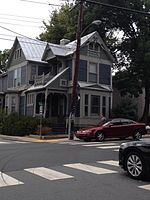Gardner–Mays Cottage
Charlottesville, Virginia Registered Historic Place stubsHistoric district contributing properties in VirginiaHouses completed in 1891Houses in Charlottesville, VirginiaHouses on the National Register of Historic Places in Virginia ... and 3 more
NRHP infobox with nocatNational Register of Historic Places in Charlottesville, VirginiaUse mdy dates from August 2023

Gardner–Mays Cottage is a historic home located at Charlottesville, Virginia. It was built in 1891, and is a one-over-one-room stucco cottage on a low foundation with an original one-room rear wing. The house is typical of the many small worker's cottages built in Fifeville.It was listed on the National Register of Historic Places in 1982. It is located in the Fifeville and Tonsler Neighborhoods Historic District.
Excerpt from the Wikipedia article Gardner–Mays Cottage (License: CC BY-SA 3.0, Authors, Images).Gardner–Mays Cottage
King Street, Charlottesville
Geographical coordinates (GPS) Address Nearby Places Show on map
Geographical coordinates (GPS)
| Latitude | Longitude |
|---|---|
| N 38.028888888889 ° | E -78.498888888889 ° |
Address
King Street 1023
22903 Charlottesville
Virginia, United States
Open on Google Maps









